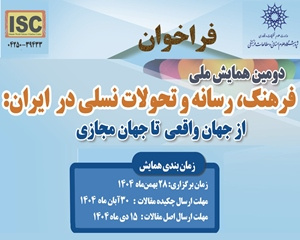کاربرد دمای احساسی مبتنی بر تئوری نسبت طلایی در ارزیابی شرایط آسایش انسانی کلان شهرهای ایران (مقاله علمی وزارت علوم)
درجه علمی: نشریه علمی (وزارت علوم)
آرشیو
چکیده
احساس راحتی انسان تا حد درخور توجهی به فراسنج های آب و هوایی و البته ویژگی ها جغرافیایی بستگی دارد. پژوهش های معدودی وجود دارد که نقش این دو دسته از عوامل را در کنار هم در مبحث آسایش انسانی در نظر گرفته باشند. پژوهش حاضر با این دیدگاه تلاش دارد سطوح مختلف آسایش انسانی را با استفاده از شاخص دمای احساسی مبتنی بر تئوری نسبت طلایی در کلان شهرهای ایران ارزیابی کند. پارامترهای دمای کمینه و بیشینه رطوبت کمینه و بیشینه، بارش و میانگین سرعت باد در گام زمانی روزانه برای 13 کلان شهر ایران برای دوره آماری (2020-1991) از سازمان هواشناسی کشور دریافت شد و در محاسبه شاخص «دمای احساسی» (ST) استفاده شد. این شاخص مبتنی بر «تئوری نسبت طلایی» و «دمای بهینه آسایش واقعی» (AOCT) طراحی شده است و از قابلیت های مهم آن انعطاف پذیری قابل توجه نسبت به تغییرات عرض جغرافیایی، ارتفاع و فصل است. نتایج نشان داد، همبستگی قابل توجه (0/867-) معکوس و معنادار (α>0/01) بین عرض جغرافیایی و دمای بهینه آسایش وجود دارد و این ارتباط برای پارامتر ارتفاع نیز با ضریب (0/607-) در سطح (α>0/05) معنا دار بود. شهرهای بندرعباس و اهواز بیشترین درصد فراوانی احساس حرارتی داغ و تبریز بیشترین درصد فراوانی روزهای خیلی سرد را داشتند. بیشترین توزیع ماهانه شرایط آسایش حرارتی برای شهر رشت برآورد شد. برای فصل تابستان، شهر تبریز با مجموع ۲۱ درصد شرایط آسایشی، با اختلاف، وضعیت بهتری در بین دیگر شهرها دارد؛ درحالی که اهواز، بندرعباس، کرمان و یزد هیچ موردی از هیچ یک از سطوح آسایشی را در این فصل تجربه نکرده اند. بیشترین درصد فراوانی شرایط آسایش کامل برای فصل پاییز برآورد شده است؛ به گونه ای که در ۹ مورد از ۱۳ شهر، آستانه غالب بوده است. استفاده از تمام فراسنج های اصلی آب و هوایی و امکان اعمال تصحیحات متنوع، قابلیت استفاده در گستره درخور توجهی از عرض های جغرافیایی و مناطق با ارتفاع متفاوت را برای شاخص ST فراهم آورده است.The Application of Somatosensory Temperature based on Golden Ratio Theory in Evaluating the Human Comfort Conditions of Iranian Metropolis
Human comfort is significantly affected by climatic parameters and geographical features. There are few studies that have focused on the role of these two factors together in human comfort. Considering this, this research tried to evaluate different levels of human comfort using the Somatosensory Temperature (ST) index based on the golden ratio theory in 13 Iranian metropolitan cities. The parameters of minimum and maximum temperature, minimum and maximum humidity, precipitation and average wind speed were obtained from the Iran Meteorological Organization for (1991-2020) period. The ST index was designed based on the Golden Ratio theory and the Actual Optimum Comfort Temperature (AOCT) and its important features are significant flexibility to changes in latitude, altitude, and season. The results showed that there is a significant (α<0.01) inverse correlation (-0.867) between latitude and optimal comfort temperature, and this relationship for the height parameter is also with the correlation (-0.607) was significant at the 0.05 level. Bandar Abbas and Ahvaz had the highest frequency of hot thermal sensation and Tabriz had the highest frequency of very cold days. The highest monthly distribution of thermal comfort conditions is estimated for Rasht. For the summer, Tabriz with a total of 21% comfortable conditions has the best situation among other cities, while Ahvaz, Bandar Abbas, Kerman and Yazd have not experienced any of the comfort levels in this season. The highest percentage of the frequency of complete comfort conditions belongs to the autumn, so that in this season, complete comfort prevailed in 9 cities. The use of all the main climate parameters and the possibility of applying various corrections have provided the ST index with the ability to be used in a significant range of latitudes and regions with different altitudes.








